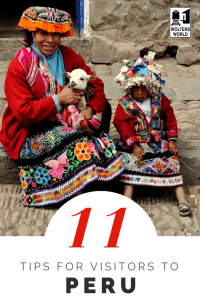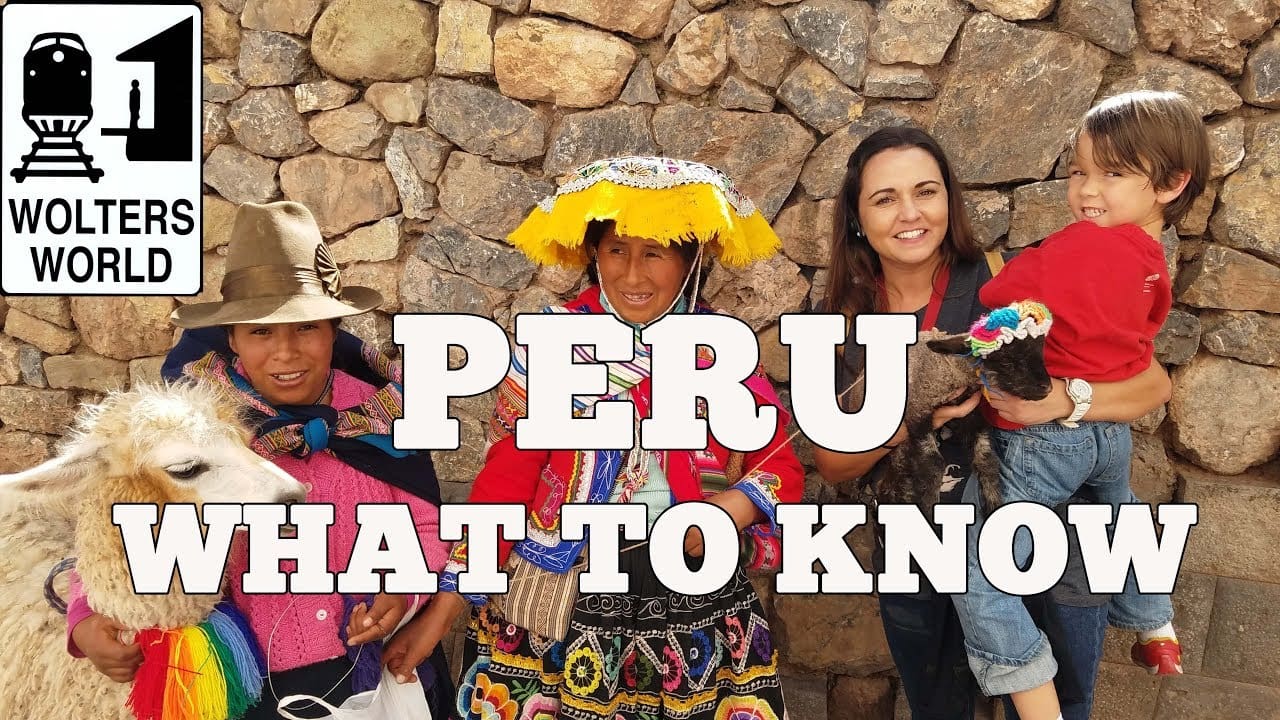Peru Travel Tips: Facts About Peru That You Should Know Before You Visit
Greetings from Arequipa, Peru! From the Amazon rainforest to the north, to the desert and the mountains, there are so many places to visit in Peru beyond Lima, Cusco and Machu Picchu. Of course, Lima, Cusco and Machu Picchu are all wonderful places to visit in Peru, too. Even when you look at Peruvian history, you think of the Incas, but they were only around for a couple of hundred years. There are so many other Pre-Colombian civilizations in Peru’s history that you can learn about.

Peru Travel Tip #1: Money in Peru
The money in Peru is the sol, or soles. Sometimes you’ll hear it called the Nuevo Sol, but just Sol is fine. The paper bills come in 200, 100, 50, 20 and 10 Soles. The coins come in 5, 2, 1 and 0.50 Soles. (There are more coins, but you probably won’t come across them in your travels.)
When it’s time to get cash in Peru, you’ll see a lot of people changing money in the streets. In Lima, you’ll see guys in maroon jackets out in front of the banks where you can exchange your money. The locals use this method a lot, and you can as well, however you will also find ATM’s around Peru where you can withdraw money. The ATM’s charge a pretty hefty fee, however, about $5, and they also put a limit on the amount you can withdraw. This means you have to withdraw more often, paying ATM fees more often.
Peru Travel Tip #2: Tipping in Peru
While many places in Peru will accept dollars or soles, it’s recommended that you tip in soles. Tipping in Peru is around 10% in a restaurant. For tours in Peru, you might tip 10-15 soles for a one to three-hour tour, or 20 soles for a full-day tour.
Watch: Tipping in Peru
Peru Travel Tip #3: Inca Trail Reservations
If you are planning to hike the Inca Trail during the U.S. summer months of June, July or August, you need to make your Inca Trail reservations four to six months in advance. If you are coming in the winter, it’s not as hard to get a spot.
The Don’ts of Visiting Peru
Peru Travel Tip #4: Language in Peru
Spanish is the official language of Peru. Quechua is another official language of Peru. Not many people in Peru speak English, outside of the tourism industry. It will make your travels much easier if you learn a few Spanish phrases before your visit. A few simple examples:
- Hello = Hola
- Yes = Si
- No = No
- Please = Por Favor
- Thank You = Gracias
Peru Travel Tip #5: Safety in Peru
Overall, I feel very safe in Peru, especially when compared to other South American countries. Of course, there are pickpockets like any heavily touristy area. However, there are a couple of real dangers to consider when you visit Peru. The high altitude of Peru makes the UV rays much stronger, so having good sunblock (and a hat) is imperative. The second danger is also due to the altitude: altitude sickness. Many destinations in Peru are at a high altitude, including Cusco at 11,000 feet (3300m.) You might experience dizziness, headaches, and vomiting. Altitude sickness can be bad enough to require a hospital visit! As soon as you start to experience altitude sickness, go to a pharmacy, tell them you have “mal de altura.” Altitude sickness in Peru is so common that some hotels even keep oxygen on hand for guests. `
Watch: How to Deal With Altitude Sickness in Peru
Peru Travel Tip #6: Toilets in Peru
The biggest thing to know about toilets in Peru is that most of them can’t handle toilet paper. Most of the time, you will put your used toilet paper in the waste-bin next to the toilet. Combined with travel tummy issues that many people get, this can be a bit gross, so just know going in that you shouldn’t flush your toilet paper in Peru.

Peru Travel Tip #7: Food in Peru
Peru has some amazing food! Now that I’ve been traveling in Peru for a few weeks, I understand why Peruvian restaurants are becoming so popular around the world. There are some unique Peruvian foods you might want to try. Cuy, or guinea pig, might be served whole, spread-eagle on the plate, or cut up and fried. My kids loved alpaca steaks; the five-year-old ate a whole steak and asked for more. Ceviche is really popular in Peru, and you’ll often see it served as a starter dish. Beef in Peru is really good, as is the seafood. The Pisco Sour is a famous Peruvian cocktail, and Inca Kola is a must for the kids. It looks like pee, but it tastes like bubble gum and Sprite. Also, do not drink the tap water in Peru.
Peru Travel Tip #8: Getting Around Peru
Peru is a vast country, with diverse landscapes. If you want to see a lot of it, you will most likely fly from region to region. Most of the flights from Lima are only about an hour, so it’s pretty easy to get around Peru by airplane. If you are visiting Peru with kids, the airports may have special lanes for families with small children. There are many travel agencies in Peru that will help you arrange your trips. Tourism is only second to mining in Peru, so the tourism industry is really well developed. Just beware, flights to see the Nazca lines have been known to make a few tourists sick to their stomachs.
When you aren’t flying in Peru, you’ll take buses to get around. The roads can be bumpy and uncomfortable. There are different levels of bus service in Peru, and you get what you pay for. If you want comfort, you will pay more for it.
In the larger cities of Peru, everybody is or knows a taxi driver. When you take a taxi in Peru, you want to negotiate the price before you get in the car. You don’t have to tip the taxi drivers, just agree to the amount up front. If you prefer, your hotel can arrange a taxi for you. Traffic in Peru is insane, so if you are walking around, you really have to pay attention to not get hit.
Peru Travel Tip #10: Best Time to Visit Peru
You are probably wondering when is the best time to visit Peru. The dry season is April through October, and peak tourist season is July and August. Rainy season in Peru is November through March, but it can vary. On our December visit, we experienced very little rain. Plus, pisco and Peruvian food make you not mind the rain! Rainy season can be a misnomer in some areas, but expect a lot of rain in the rainforests. No matter when you visit Peru, be prepared for rain with a jacket or poncho!
Peru Travel Tip #10: Staying Connected in Peru
All of our hotels in Peru had WiFi and we found WiFi at cafes in tourist spots, too. When you need to charge your devices, most hotels offer a European plug and a U.S. plug, so you won’t need an adapter if you stay in modern hotels. The voltage, though, is 220, so you will need a converter if it isn’t already built into your electronics. (Brazilian or UK plugs don’t work in Peru, so you’ll need an adapter for those.)
Per Travel Tip #11: What to Wear in Peru
Temperatures in Peru range from mildly cold to very hot, so the best thing you can do is watch the forecast before your trip. When deciding what to wear in Peru, the most important thing to pack is a good pair of walking shoes or hiking boots. The other thing to pack for Peru is a hat to shade you from the sun.
Additional Peru Travel Tips & Resources
These tips should be a good start to prepare you for your trip to Peru! For more Peru travel tips, check out some of our other travel videos:
- Ten Things That Will Shock You About Peru
- Five Tips for Getting More Out of Arequipa
- The Don’ts of Visiting Peru
